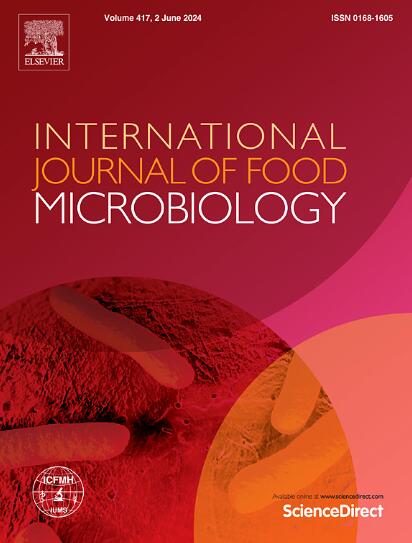Effect of incubation temperature, time, and freezing on diversity of Campylobacter spp. recovered from naturally contaminated retail beef livers
IF 5.2
1区 农林科学
Q1 FOOD SCIENCE & TECHNOLOGY
International journal of food microbiology
Pub Date : 2025-05-27
DOI:10.1016/j.ijfoodmicro.2025.111286
引用次数: 0
Abstract
Retail beef livers are often contaminated with Campylobacter species and represent a potential transmission route for human infections. The aim of this study was to evaluate the effect of incubation temperature and time on the isolation rate of different Campylobacter species from retail bovine liver juice samples, and the effect of freezing on the recovery of Campylobacter spp. from the naturally contaminated liver samples. Fresh retail beef liver packages (N = 20), packed in modified atmosphere, were purchased from local stores and examined using direct culture on mCCDA. All colonies grown under microaerobic conditions at either 37 °C or 41.5 °C were identified to genus and species levels using real-time colony polymerase chain reaction, and a representative collection of the Campylobacter isolates was further characterized using whole-genome sequencing by Illumina. The plates were inspected after incubation of 24, 48, and 72 h. Liver pieces were stored in the freezer at −20 °C and re-examined after thawing using both direct culture and enrichment in parallel. Campylobacter spp. were detected from 17 (85 %) of the fresh beef liver juice samples, compared with four (20 %) after freezing (P < 0.0001). C. jejuni was the most common species detected in all 17 Campylobacter-positive samples, followed by C. fetus detected in 6 samples prior to freezing. C. coli, C. lari, and C. hyointestinalis were not detected in any of the samples. The isolation rate of C. fetus from beef liver juice improved by lowering the incubation temperature from 41.5 °C to 37 °C and extending the incubation time from 48 to 72 h. Also, C. jejuni was isolated more often at 37 °C than at 41.5 °C. C. fetus subsp. fetus sequence type (ST)-6 was the most common finding from fresh liver juice samples (5/20), followed by C. jejuni ST-48 (4/20) and ST-58 (4/20). Several samples were contaminated with multiple STs or species. Freezing caused a 0.6–1.4 log reduction in the Campylobacter spp. count but did not completely eliminate the risk of transmission, particularly for samples starting with high-level natural contamination.
培养温度、时间和冷冻对天然污染零售牛肝中弯曲杆菌多样性的影响
零售牛肉肝经常被弯曲杆菌污染,是人类感染的潜在传播途径。本研究旨在探讨不同培养温度和时间对零售牛肝汁中不同弯曲杆菌分离率的影响,以及冷冻对天然污染牛肝样品中弯曲杆菌分离率的影响。从当地商店购买新鲜零售牛肝包装(N = 20),在改性空气中包装,并使用mcda直接培养进行检测。所有在37°C或41.5°C的微氧条件下生长的菌落通过实时集落聚合酶链反应鉴定到属和种水平,并通过Illumina全基因组测序进一步鉴定具有代表性的弯曲杆菌分离物。培养皿孵育24、48和72小时后检查。肝片保存在- 20°C的冰箱中,解冻后使用直接培养和平行富集方法重新检查。新鲜牛肝汁中检出弯曲杆菌17例(85%),冷冻后检出弯曲杆菌4例(20%)(P <;0.0001)。在所有17份弯曲杆菌阳性样本中,以空肠梭菌最多检出,其次是冷冻前6份样本中检出的胎儿梭菌。所有样品均未检出大肠杆菌、拉里大肠杆菌和舌肠大肠杆菌。将培养温度从41.5℃降低到37℃,将培养时间从48 h延长到72 h,可提高牛肝汁中C.胎儿的分离率,37℃条件下空肠C.的分离率高于41.5℃条件。C.胎儿亚纲;新鲜肝汁样品中最常见的是ST -6型(5/20),其次是空肠梭菌ST-48型(4/20)和ST-58型(4/20)。一些样品被多种STs或物种污染。冷冻导致弯曲杆菌数量减少0.6-1.4 log,但并没有完全消除传播的风险,特别是对于高水平自然污染的样品。
本文章由计算机程序翻译,如有差异,请以英文原文为准。
求助全文
约1分钟内获得全文
求助全文
来源期刊
CiteScore
10.40
自引率
5.60%
发文量
322
审稿时长
65 days
期刊介绍:
The International Journal of Food Microbiology publishes papers dealing with all aspects of food microbiology. Articles must present information that is novel, has high impact and interest, and is of high scientific quality. They should provide scientific or technological advancement in the specific field of interest of the journal and enhance its strong international reputation. Preliminary or confirmatory results as well as contributions not strictly related to food microbiology will not be considered for publication.

 求助内容:
求助内容: 应助结果提醒方式:
应助结果提醒方式:


